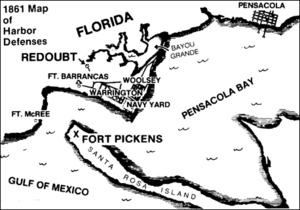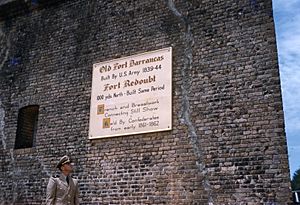Fort Barrancas facts for kids
|
Fort San Carlos De Barrancas
|
|

Aerial view of Fort Barrancas. The water battery is the white section.
|
|
| Location | Warrington, Florida, U.S. |
|---|---|
| Nearest city | Pensacola |
| Built | 1787 |
| NRHP reference No. | 66000263 |
Quick facts for kids Significant dates |
|
| Added to NRHP | October 15, 1966 |
| Designated NHL | October 9, 1960 |
Fort Barrancas is an old military fort in Pensacola, Florida. It's also known as Fort San Carlos de Barrancas. This historic fort is located inside Naval Air Station Pensacola. It sits on a hill overlooking Pensacola Bay.
The fort has a long and interesting history. It was first built by the Spanish in the late 1700s. Over the years, it was rebuilt and expanded by different countries. Today, Fort Barrancas is a National Historic Landmark. It is managed by the National Park Service and is open for visitors to explore.
Contents
The Fort's Early Days
Building the First Forts
The Spanish first built a fort here in 1698. They called it Fort San Carlos de Austria. In 1707, Native American groups tried to capture it but didn't succeed. Later, in 1719, French forces took over Pensacola and destroyed the Spanish fort.
After a big war, Britain took control of West Florida in 1763. They built their own defense called the Royal Navy Redoubt. This was a harbor fortification made of earth and logs.
Spanish Return and New Fort
The Spanish joined the American Revolutionary War against the British in 1779. They captured Pensacola in 1781. After the war, Spain got West Florida back. They finished building a new fort called Fort San Carlos de Barrancas in 1797. The word Barranca means "bluff" in Spanish. This name describes the high ground where the fort was built.
Under U.S. Control
First Battles and Changes
During the War of 1812, British troops abandoned Fort San Carlos De Barrancas. This happened when American troops, led by General Andrew Jackson, were approaching. The British blew up parts of the fort before leaving.
In 1818, General Jackson's American forces fought with the Spanish at the fort. After a few days, the Spanish surrendered. This left Pensacola in American hands.
When the United States bought Florida from Spain in 1821, Pensacola became important. It was chosen as the site for a major Navy Yard. To protect this area, the U.S. planned new forts. Fort Pickens was built on Santa Rosa Island by 1834. Fort McRee was finished in 1839.
Rebuilding Fort Barrancas
Between 1839 and 1844, Fort Barrancas was rebuilt and made much stronger. The old Spanish fort on the hilltop was replaced with a huge brick fortress. It was designed to defend against ships and land attacks. An Advanced Redoubt was also built north of the fort. This system protected the Navy Yard from enemy soldiers.
The new Fort Barrancas was designed by Joseph Gilbert Totten. Major William Henry Chase oversaw the construction. An underground tunnel connected the main fort to the old Spanish water battery.
The Civil War Era
Early Conflicts
The American Civil War began officially in April 1861. But even before that, there was a conflict at Fort Barrancas. On January 8, 1861, Florida state troops demanded the fort's surrender. U.S. Army soldiers, led by Lieutenant Adam J. Slemmer, fired shots to stop them. Slemmer knew Fort Pickens was easier to defend. So, he moved his troops and supplies across the bay to Fort Pickens. The Union Army held Fort Pickens throughout the war.

Confederate soldiers from Alabama, Louisiana, and Mississippi took over Fort Barrancas. They added more defenses along the coast. General Braxton Bragg commanded the Confederate forces in Pensacola.
Battles and Abandonment
On October 9, 1861, Confederate troops tried to attack Fort Pickens but were pushed back. Fort McRee and Fort Barrancas exchanged heavy cannon fire with Fort Pickens. This happened on November 22–23, 1861, and again on January 1, 1862.
However, in May 1862, the Union Army captured New Orleans. Because of this, Confederate troops left Pensacola and abandoned Fort Barrancas.
After the Wars
Becoming Obsolete
New weapons like stronger cannons and ironclad ships appeared during the Civil War. These made old masonry forts like Fort Barrancas less useful. The fort was then used by the Army for other purposes. It served as a signal station, a place for small arms practice, and a storage area until 1946.
After World War II, new weapon technology made coastal defense forts completely outdated. On April 15, 1947, Fort Barrancas was officially closed as a military fort.
A Historic Landmark Today
The U.S. Navy took over the site and made it part of Naval Air Station Pensacola. But people wanted to protect its history. In 1960, Fort San Carlos de Barrancas was named a National Historic Landmark.
In 1971, Congress created the Gulf Islands National Seashore. Fort Barrancas became part of this new national park. After a big restoration project from 1978 to 1980, Fort Barrancas was opened to the public.
Today, Fort Barrancas and the nearby Advanced Redoubt are managed by the National Park Service. They are still located on Naval Air Station Pensacola. Visitors need to get permission at the base's security checkpoint to enter.
Visiting Fort Barrancas
Fort Barrancas has a visitor center for the Gulf Islands National Seashore. The center has exhibits that tell the story of the fort. Visitors can explore the restored fort and its old artillery battery. Tours of the Advanced Redoubt are also available. It's a great place to learn about American history and see an old military fort up close.
Images for kids
See also
 In Spanish: Fuerte Barrancas para niños
In Spanish: Fuerte Barrancas para niños



